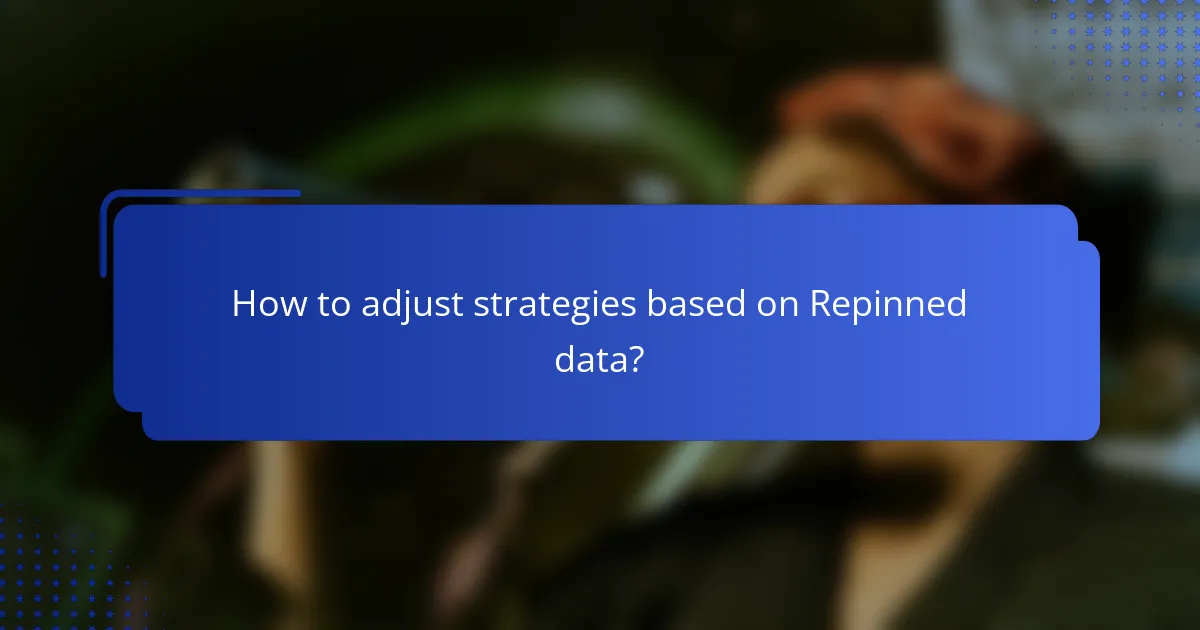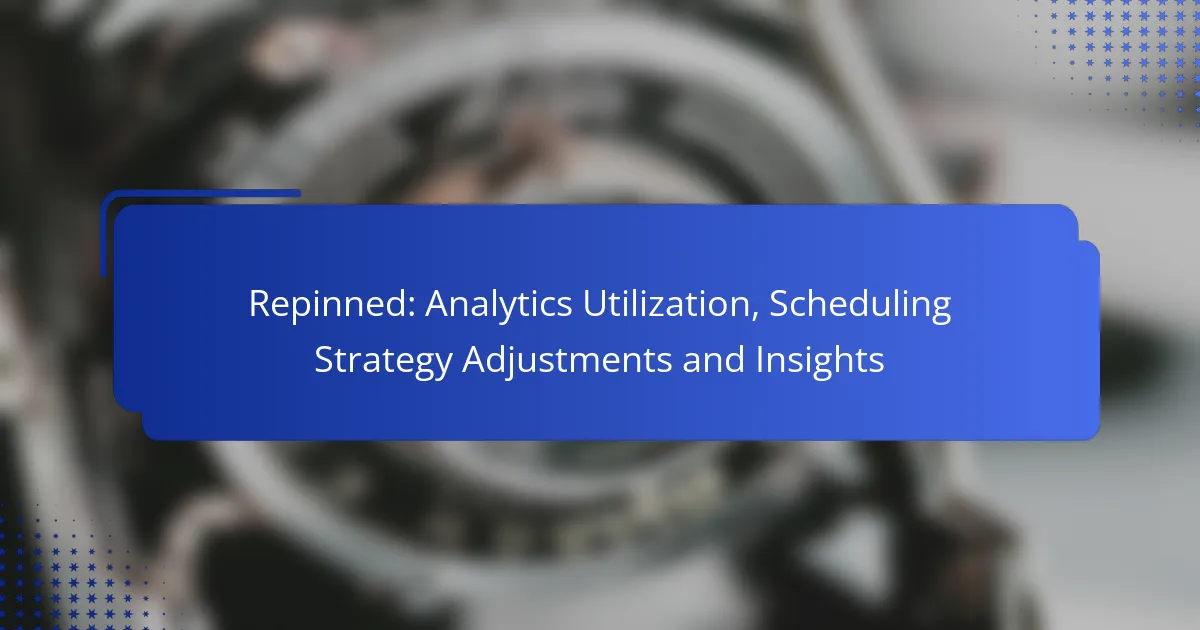Repinned analytics offer crucial insights that can elevate business performance in Australia by enhancing user engagement and optimizing content strategies. By understanding audience behavior and adjusting posting schedules based on these analytics, companies can significantly improve their visibility and interaction rates. Leveraging these insights allows creators to refine their approach and better connect with their target audience.

How can Repinned analytics improve performance in Australia?
Repinned analytics can significantly enhance performance in Australia by providing insights that help businesses understand user engagement and optimize their content strategies. By leveraging these analytics, companies can make informed decisions that lead to increased visibility and interaction with their target audience.
Enhanced engagement tracking
Enhanced engagement tracking allows businesses to monitor how users interact with their content on platforms like Pinterest. This includes metrics such as clicks, saves, and shares, which are crucial for understanding what resonates with the audience. In Australia, companies can use these insights to refine their content and improve overall engagement rates.
To effectively track engagement, consider using tools that provide real-time data and visual analytics. Regularly reviewing these metrics can help identify trends and patterns, enabling timely adjustments to content strategies.
Data-driven content optimization
Data-driven content optimization involves using analytics to refine and enhance the quality of the content shared. By analyzing which types of posts perform best, businesses can focus on creating similar content that appeals to their audience. In the Australian market, this could mean tailoring visuals and messaging to reflect local culture and preferences.
Utilize A/B testing to compare different content formats and styles. This method allows businesses to see which variations yield better results, helping to allocate resources effectively and maximize return on investment.
Audience insights for targeted strategies
Audience insights provide valuable information about the demographics and preferences of users engaging with content. In Australia, understanding the local audience’s interests and behaviors can lead to more targeted marketing strategies. This could involve segmenting the audience based on age, location, or interests to tailor content accordingly.
To gather audience insights, consider using surveys or feedback tools alongside analytics. This combination can help create a more comprehensive understanding of the audience, leading to strategies that are more likely to convert and engage effectively.

What scheduling strategies maximize Repinned effectiveness?
To maximize Repinned effectiveness, focus on timing your posts and adjusting frequency based on analytics. Understanding when your audience is most active and how often to engage them can significantly enhance visibility and interaction rates.
Optimal posting times for Australian audiences
For Australian audiences, the best posting times typically fall during early mornings and late evenings, aligning with common commuting hours and leisure time. Aim for weekdays, particularly Tuesday to Thursday, when engagement tends to peak.
Consider testing specific time slots, such as between 7 AM – 9 AM and 6 PM – 8 PM AEST, to identify when your content receives the most interaction. Utilizing analytics tools can help pinpoint these optimal times based on your specific audience’s behavior.
Frequency adjustments based on analytics
Adjusting posting frequency based on analytics is crucial for maintaining audience engagement without overwhelming them. A general guideline is to post 3 to 5 times a week, but this can vary depending on audience response and content type.
Regularly review engagement metrics to determine if your current frequency is effective. If engagement decreases, consider reducing the number of posts or varying content types to keep your audience interested. Avoid posting too frequently, as this can lead to audience fatigue and decreased interaction.

What insights can be derived from Repinned analytics?
Repinned analytics provide valuable insights into content performance and user engagement, helping creators refine their strategies. By analyzing these metrics, users can identify what resonates with their audience and adjust their approach accordingly.
Content performance metrics
Content performance metrics focus on how well individual pieces of content are doing in terms of views, repins, and clicks. Key metrics include the number of repins, the engagement rate, and the click-through rate (CTR). For example, a high repin count indicates that users find the content appealing, while a low CTR may suggest that the content needs improvement.
To effectively analyze content performance, track these metrics over time and compare them against industry benchmarks. This can help identify trends and areas for improvement. Regularly updating your content based on these insights can significantly enhance its visibility and effectiveness.
User interaction trends
User interaction trends reveal how audiences engage with your content, including patterns in repinning and clicking behavior. Analyzing these trends can help you understand peak engagement times, preferred content types, and audience demographics. For instance, if you notice that certain topics perform better during specific seasons, you can tailor your content calendar accordingly.
To leverage user interaction trends, consider segmenting your audience based on their engagement patterns. This allows for more targeted content creation and scheduling. Additionally, be mindful of common pitfalls, such as ignoring low-performing content or failing to adapt to changing user preferences.

How to adjust strategies based on Repinned data?
Adjusting strategies based on Repinned data involves analyzing engagement metrics to refine content and scheduling. By understanding which pins resonate most with your audience, you can optimize your approach for better performance.
Iterative content testing
Iterative content testing is a method where you continuously experiment with different types of content to see what performs best. Start by creating variations of your pins, such as different images, headlines, or descriptions, and track their performance over time.
For effective testing, consider using A/B testing techniques. This means showing two different versions of a pin to similar audience segments and comparing engagement rates. Aim for a minimum testing period of a few weeks to gather meaningful data.
Feedback loops for continuous improvement
Establishing feedback loops is crucial for ongoing strategy enhancement. Regularly review Repinned data to identify trends and patterns in user engagement. This can help you understand what content is resonating and what needs adjustment.
Incorporate insights from your audience by monitoring comments and shares. Use this qualitative feedback alongside quantitative metrics to refine your content strategy. Aim to implement changes based on feedback at least quarterly to stay relevant and engaging.

What are the prerequisites for effective Repinned analytics utilization?
Effective Repinned analytics utilization requires a clear understanding of your audience and well-defined performance goals. These elements ensure that your analytics efforts align with your overall marketing strategy and drive meaningful insights.
Understanding audience demographics
To leverage Repinned analytics effectively, you must first grasp the demographics of your audience. This includes age, gender, location, and interests, which can significantly influence engagement and content performance.
Utilize tools like Google Analytics or social media insights to gather demographic data. For instance, if your audience skews younger, consider tailoring your content to trends that resonate with that age group, potentially increasing engagement rates.
Setting clear performance goals
Establishing clear performance goals is crucial for effective analytics utilization. Goals should be specific, measurable, achievable, relevant, and time-bound (SMART). For example, aim to increase engagement by a certain percentage within a defined period.
Regularly review and adjust these goals based on analytics insights. If a particular type of content performs exceptionally well, consider setting a goal to produce more of that content. This iterative approach helps refine your strategy and maximize results.

How does Repinned compare to other analytics tools?
Repinned stands out among analytics tools by offering tailored insights specifically for social media platforms, focusing on engagement metrics and user behavior. Unlike general analytics tools, it provides specialized features that cater to content creators and marketers looking to optimize their social media strategies.
Unique features of Repinned
Repinned includes unique features such as visual content analysis, which helps users understand which images or videos resonate most with their audience. Additionally, it offers real-time engagement tracking, allowing users to adjust their strategies on the fly based on current performance metrics.
Another notable feature is the ability to generate customized reports that highlight key performance indicators relevant to specific campaigns. This targeted approach enables users to make data-driven decisions that align with their marketing goals.
Integration capabilities with other platforms
Repinned integrates seamlessly with various social media platforms, including Instagram, Pinterest, and Facebook, enabling users to pull data directly from their accounts. This integration simplifies the process of analyzing performance across different channels without the need for manual data entry.
Moreover, Repinned can connect with popular marketing tools like Mailchimp and Hootsuite, allowing for a more cohesive marketing strategy. Users can automate reporting and scheduling, ensuring that their content is optimized for maximum engagement across all platforms.

What are the emerging trends in social media analytics?
Emerging trends in social media analytics focus on real-time data processing, enhanced user engagement metrics, and the integration of artificial intelligence. These trends enable businesses to make informed decisions based on immediate feedback and deeper insights into audience behavior.
Analytics Utilization
Analytics utilization involves leveraging data to understand audience preferences and optimize content strategy. Companies are increasingly using tools that provide insights into engagement rates, reach, and conversion metrics. This data helps in tailoring content to meet the specific interests of target demographics.
For effective analytics utilization, businesses should prioritize key performance indicators (KPIs) that align with their goals. Common KPIs include engagement rates, follower growth, and click-through rates. Regularly reviewing these metrics can guide content adjustments and improve overall strategy.
Scheduling Strategy Adjustments
Adjusting scheduling strategies is essential for maximizing audience reach and engagement. Analyzing when followers are most active allows brands to post content at optimal times. Tools like social media management platforms can provide insights into peak engagement periods.
Consider testing different posting times and frequencies to identify what works best for your audience. For example, brands may find that posting during weekday afternoons yields higher engagement than weekends. Regularly revisiting and adjusting your schedule based on analytics can lead to improved performance.
Insights
Insights derived from social media analytics can drive strategic decisions and enhance marketing effectiveness. By interpreting data trends, brands can identify successful content types and areas needing improvement. This understanding can inform future campaigns and content creation efforts.
To gain actionable insights, consider segmenting data by demographics or behavior. For instance, analyzing engagement by age group can reveal which content resonates best with different audiences. Implementing these insights into your strategy can lead to more targeted and effective marketing efforts.
